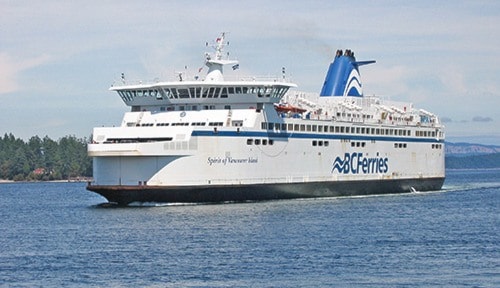B.C Ferries is working with the Marine Workers’ Union to deal with asbestos on its vessels.
This year, B.C Ferries will receive three new vessels, two of which are set to serve routes among the Gulf Islands.
“The plan is to replace our vessels with asbestos-free vessels. We want to get the asbestos out of our system …” said David Fagen, executive director of safety and health for B.C Ferries.
Fagen said most of the asbestos is in the engine room areas, and is related to exhaust from the engine for fire protection.
“Asbestos has typically been used for a fire or heat protection purpose in the construction of our vessels in the past,” he said.
Graeme Johnston, president of the B.C Ferry and Marine Workers’ Union said that the newer vessels are asbestos free but that on many of the older vessels, asbestos remains pervasive.
“As for carcinogenic risks of an asbestos spill, there is no determined amount for what a deadly exposure to asbestos is, but case history of risks with asbestos exposure have demonstrated that neither acute nor chronic exposure are required for an asbestos exposure to be fatal.
“However, evidence does show that for exposure to asbestos to be deadly it must be in an airborne, friable state,” he said in an email to the News Review.
Fagen said the asbestos they do have on their ships is managed, meaning it’s encapsulated or enclosed behind something, so that it’s not airborne or causing any issues for the crews.
“We really care about our crews and their health, so we do everything we can to make sure that any asbestos that we do have is monitored,” said Fagen.
WorkSafe B.C., he said, has minimum standards they have to meet, but they also try to go above those standards where possible.
“We monitor, we do inventories and surveys, and we do inspections,” said Fagen.
In terms of abatement measures, in the past five years, they’ve spent 4.5 million dollars in abatement, and they try to make sure that abatement is done in an area where there’s already work happening. Currently, B.C. Ferries has a capital plan to replace around 10 vessels over the next 12 years. The Queen of Burnaby for example, has asbestos in her and will be replaced by a new vessel that’s asbestos free.
Since 2008, seven new vessels have been brought into service, and the Salish Orca will be the first of the three new vessels being replaced this year.
With an increased removal of vessels containing asbestos, they are also aging and therefore should be replaced. The Gulf Islands will see two new vessels in service this year; The Salish Raven and the Salish Eagle.
